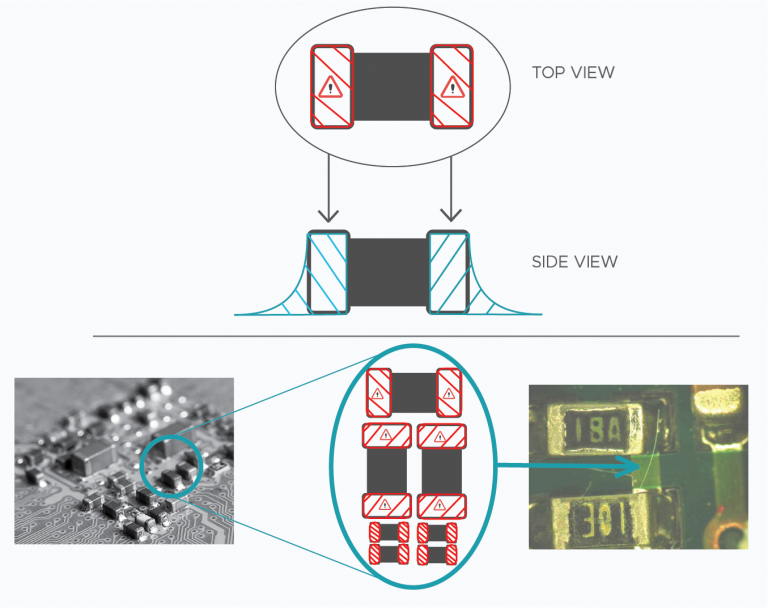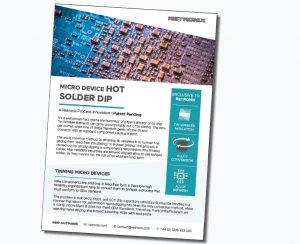PASSIVE COMPONENTS TINNING
The industry now has a comprehensive all-inclusive solution for tinning requirements.
It’s a well-known fact (there are hundreds of technical papers confirming), that Tin Whisker filaments can grow uncontrollably from tin plating. The danger comes when one these filaments peels away from tin & connects with an adjacent component thus causing a short.
The most common method to eliminate tin whiskers is to convert the plating from ‘lead-free’ (tin plating) to tin/lead plating. The process is carried out by simply dipping a component’s terminations into tin-lead solder. High Reliability industries are allowed dispensation to use tin/lead solder, as they cannot run the risk of tin whiskers long term.
New components are sold only in lead-free form & therefore High Reliability organisations must convert them to tin/lead, a process that has to conform to GEIA Standard. The problem is that smaller components such as 0402, 0603, and SOT chip capacitors could not (until now) be handled in an automated process. Hand-dipping has been the only conversion method, which can be costly, time-consuming, does not meet GEIA Standards & has more potential for inconsistent application. Many manufacturers are rejecting hand dipping & instead are assembling PCBs with lead paste.
The consequence of this work around is that the lead solder from the paste only covers the sides of the termination but does not reach the top surface. As widely reported by NASA, the lead paste process DOES NOT protect against the risk of Tin Whiskers. The below images from a study conducted by NASA show tin whiskers forming on all sides of terminations.
Another major study that was conducted by NASA includes Tin whisker growth and field failures. The full study and presentation can be found by clicking here
LEAD PASTE FAILINGS
The success of solder dipping as a solution to protect against Tin Whiskers directly depends on coating the exposed tin-plated surface. As components reduce in size, the distance between terminations reduces, increasing the risk of shorts caused by tin whiskers. On densely packed PCBs, there is the additional risk of shorting to adjacent components. Some companies acknowledge this, others ignore it as they have no solution.

a RETRONIX PROCESS INNOVATION | PATENT PENDING
With the automated process designed exclusively by Retronix to tin micro devices such as 0402, 0603, SOT’s to GEIA standards, the industry now has a comprehensive all-inclusive solution for tinning requirements.
- The automated micro tinning process is carried out on our plating systems.
- The lead-free capacitors are picked up by a specially designed tool that can hold multiple devices at a time.
- The devices are moved to the fluxing station & then accurately over the solder wave. The pre-programmed automated system ensures the dip is precise & consistent.
In many cases, the thought process around tinning of micro components such as capacitors and resistors was ‘there is no suitable process that meets the GEIA standard therefore, it’s not a problem’, so issue a concession to bypass it. Or do the above which is a partial solution but not good enough.
Now however, the Retronix Micro Device | Hot Solder Dip process offers a solution to tin even the smallest and most awkward of components to GEIA standard.

FURTHER INFORMATION IS AVAILABLE
Our Passives Tinning Process brochure provides further details on our process innovation which offers a solution for tinning micro components.



